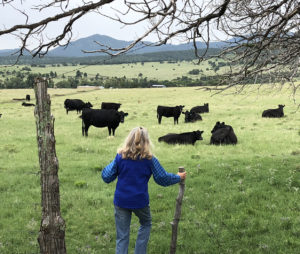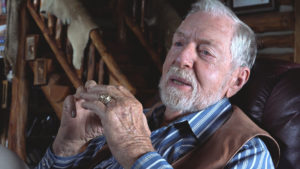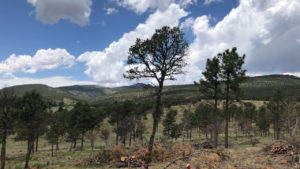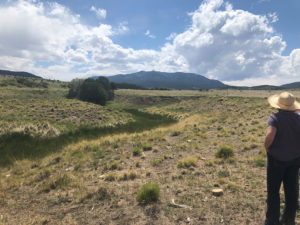Goodloes: Ranching for the Watershed on the Carrizo Ranch
—Land Management that encompasses the health of the forest, the grasses and the cows
“Watershed rehabilitation is our bottom-line goal here on the ranch,” said Sid Goodloe during a day-long workshop on his ranch as part of a “healthy soils” educational series organized by Western Landowners Alliance earlier this year. “We want to return the water to the aquifer and to produce more feed for wildlife and livestock,” he explained.
Sid and his wife, Cheryl, own the Carrizo Valley Ranch, a 3,300-acre property, all under a conservation easement held by NMLC. The ranch is located adjacent to the Lincoln National Forest, on the eastern flanks of the Jicarilla Mountains, just north of Capitan, NM. Their son, Floyd Goodloe, owns the ranch next door. The family runs cattle and has a hunting operation as well.

Cheryl Goodloe enters one of the Carrizo Ranch pastures.
“This is the Carrizo Canyon, and that’s Carrizo Mountain over there,” Sid said, pointing, “and this is the top of the watershed. The waters of this canyon drain toward the Pecos river just north of Roswell.” For more than a half century, Sid and his family have engaged in efforts to understand and restore the watershed and its grasslands – “mostly conversion from solid ‘PJ’ [piñon juniper] thickets to grasslands and savannah areas, and juniper control in the canyon riparian areas,” Sid explained.
Restoration by Grazing
This all contributes to what Sid considers the foundation of their land management: rotational or short duration grazing. “We started this in 1971 and it’s changed everything – the biodiversity, the condition of the pastures,” Sid reflects. “We move these cattle about once a week; when we have fast growth, we move them more often.”
Sid adds, “We realize we’re grass farmers, and we try and take care of the grass.”
Sid Goodloe in the living room of the couple’s log cabin, built by Sid himself.
The Goodloes move the minerals often to keep cattle from going back to the same place all the time, and they participate in the “NUTBAL” program, offered by the Center for Natural Resource Information Technology. “You collect a sample of manure every month and send it to them and they tell you what your animals are consuming. We learned, for instance, that we’re low on phosphorous so we’ve added phosphorous.”
The family completed some water relocation and development last year, with solar pumps now on all their wells. “Thank goodness I don’t have to climb those windmill towers anymore!” exclaims Sid. “Cheryl told me this summer, ‘that’s the last tower you’re climbing!’”
They also diversified the ranch operation by building a hunting cabin using lumber from the original home built in 1959. “We have a real good fee hunting business with elk and deer,” Sid said. “The Department of Game and Fish rewarded us with a trophy buck season in December [2018] because of our habitat work,” he added proudly.
The Goodloes actively manage their forested land
Forest Health by Fire
Adjacent to the Lincoln National Forest, a portion of the Carrizo Ranch is forested and the family has spent decades improving the forest health on their land. Sid is a strong advocate for prescribed burning. “It seems to fit better than anything but it’s very difficult to do here now,” he explained, citing the notorious Little Bear fire seven years ago near Ruidoso, NM that burned 44,000 acres and 242 homes. The Goodloes have had to resort to thinning trees instead, then seeding grasses.
“Everything has a predator,” Sid believes, “and the predator for these trees is fire, to keep this forest, this watershed healthy. But with all the development in the area, we can’t get permission to burn.”
Still, the results of the thinning work the Goodloes have done is obvious compared to the density in the adjacent national forest – density that the U.S. Forest Service claims is ten times that of the managed forest area at the edge of the nearby Village of Ruidoso.
The Carrizo Creek
Improving Water Flow
The Carrizo Creek runs through the ranch. “We’re really proud of the work we’ve done here,” Sid said, pointing to lush green grass along both creek banks and pooling water at the bottom for wildlife. “When we started, it was completely dry and there was nothing but big boulders down there. Now there’s two and a half miles of subterranean flow. The creek used to run seasonally every year,” Sid said, sadly, “but it hasn’t run in five years.” Sid blames the overcrowding of trees from years of fire suppression in the adjacent national forest. “No water gets back to the aquifer anymore, too many trees sucking it all up, so that’s why you don’t see any springs.”
Sid fenced the entire 2.5 miles along the creek and his cows never graze that area, although he joked, “The elk get over the fences and graze in there, while my cows can’t get in . . . I guess I’m in the elk raising business, too!” #



